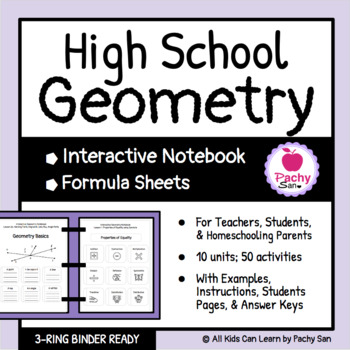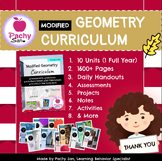High School Geometry Interactive Notebook | Printable & Digital Google Slides
- Google Drive™ folder

What educators are saying
Products in this Bundle (2)
Also included in
- Are you looking for a low-prep set of Geometry activities? Download this resource today, and watch as your students master both the content and skills in Geometry. I have included individual lessons for you to be able to find them on TPT.This Product Includes:⭐ 10 Units (1 Full Year)⭐ 1600+ Pages⭐ DPrice $110.00Original Price $564.60Save $454.60
Description
Get ready for a math adventure with our jam-packed resource! Inside, you'll find 269 pages filled with 50 fun activities, complete with clear instructions, answer keys, and helpful photo examples. Perfect for teachers, students, and homeschooling parents!
Explore 10 units covering everything from Algebra Basics to Surface Area & Volume. Each unit breaks down math concepts into easy-to-follow lessons, making learning a breeze.
Whether you're brushing up on geometry or diving into circles and triangles, our resource has something for everyone. Say hello to stress-free math learning – grab your copy today!
10 units, 269 pages, 50 activities with photo examples, instructions, and answer keys for teachers, students, & homeschooling parents
⭐ Unit 1: Algebra Basics
⭐ Unit 2: Geometry Basics
⭐ Unit 3: Parallel and Perpendicular Lines
⭐ Unit 4: Transformations
⭐ Unit 5: Quadrilaterals
⭐ Unit 6: Triangles and Right Triangles with Trigonometry
⭐ Unit 7: Congruent & Similar Triangles
⭐ Unit 8: Circles
⭐ Unit 9: Area and Perimeter
⭐ Unit 10: Surface Area & Volume
Check out my other resource!
Modified Geometry Curriculum (10 Units - 1 Year) Bundle with Links
Visit my store today!






